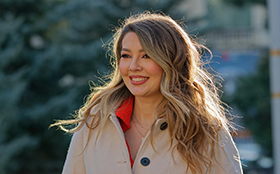一般过去时的构成(一般过去式是由什么构成的)
本文目录
一般过去式是由什么构成的
一般过去式的结构:
(1)过去式be动词类:
a:陈述句:主语+谓语动词(was/were)+表语。
thev
were
in
the
classroom
a
moment
ago.(他们刚才在教室里。)
b:一般疑问句:将be的过去式was/were提到主语前,句尾加问号。
were
they
in
the
classroom
a
moment
ago?
(回答用yes,__________或no________,)
特殊问句:特殊疑问词+一般疑问句+?(回答用句子。)
c:否定句:在be的过去式was/were后加not,可缩写成wasn’t/weren’t即可。
they
weren’t
in
the
classroom
a
moment
ago.
(2)过去式行为动词类:
a:陈述句:主语+谓语动词(规则动词v-ed或不规则动词)+宾语+状语。
they
sang
songs
in
the
classroom
a
moment
ago.(他们刚才在教室里唱歌。)b:一般问句:在陈述句前加did,将句中谓语动词的过去式变成原形,句尾加问号。did
they
sing
in
the
classroom
a
moment
ago?(回答用yes,______,或,no,_______,)特殊问句:特殊疑问词+一般疑问句+?(回答用句子。)c:否定句:在陈述句主语和谓语动词之闻加助词did
not,可缩写成didn’t。they
didn’t
sing
in
the
classroom
a
moment
ago.
规则动词变过去式方法:
(1)一般动词加-ed,例如:work——orked
(2)以辅音字母加y结尾的动词变y为i再加ed,例如:stud——studied
(3)以一个字母加一个辅音字母结尾的重读闭音节,要双写辅音字母,再加-ed,例如:stop——stopped
(五)不规则动词需要专门记忆。
一般过去时态的构成
一 构成
⑴ be→was— ( am,is 的过去式 )
were— ( are 的过去式 )
⑵ V.→V-ed ( 动词过去式 )
二 用法
⑴表示过去发生的动作或状态,通常会有明确的表示过去的时间状语.
I went to the zoo yesterday.
I stayed up last night ..
⑵叙述过去连续发生的动作或状态.
This morning ,I got up early ,went out for a walk ,then came back and cooked for my family .
⑶表示过去某一段不确定的时间内发生的动作或状态.
He worked in the store for 5 years.
⑷讲故事时用一般过去时,但描述故事发生的背景时用过去进行时.
⑸ used to do sth.过去常常(习惯)做某事
be used to doing sth 一直习惯做某事
I used to get up early.我过去常常早起.
I am used to getting up early.我一直都习惯于早起.
三 公式
⑴be→was / were
肯:S.+ was∕were+…
否:S.+ wasn’t / weren’t +…
肯疑:Was∕Were + S.+…?
Yes,S.+ was∕were.
No,S.+ wasn’t∕weren’t.
否疑:Wasn’t∕Weren’t + S.+…?
Yes,S.+ was∕were.
No,S.+ wasn’t∕weren’t.
⑵V.→V-ed
肯:S.+ V-ed+…
否:S.+ did not (didn’t )+ V原+…
肯疑:Did + S.+ V原+…?
Yes,S.+ did.
No,S.+ didn’t.
否疑:Didn’t + S.+ V原+…?
Yes,S.+ did.
No,S.+ didn’t.
一般过去时的结构和用法是什么
一般过去时的结构如下:
1、肯定形式:主语+动词过去式+其他
例句:She often came to help us in those days。那时候她经常来帮助我们。
2、否定形式:①was/were+not;②在行为动词前加didn’t,同时还原行为动词。
例句:I didn’t know you like coffee。我不知道你喜欢咖啡。
3、一般疑问句:①Did+主语+谓语动词原型+其他? ②Was/Were+主语+表语?
一般过去时的用法如下:
1、表示过去某一确定时间发生的动作或存在的状态,可能是一次性的,也可能是过去经常反复发生的,常与表示过去时间的状语连用。
如:He lost his purse yesterday。他昨天丢了钱包。
2、用于虚拟语气中,表示对现在或将来的假设,主观意图或愿望等。
如:I wish l had your brains, I’m too stupid。我希望我能拥有你的大脑,我太愚蠢了。
3、在时间、条件状语从句中,常用一般过去时代替过去将来时,表示过去将来的动作。
如:They said they would let us know if they heard any news about him。
他们说如果他们听到任何有关他的消息,就会告诉我们。
扩展资料
规则动词的过去式规则介绍
1、大部分在词尾直接加-ed,如mend-mended,wait-waited,talk-talked,discuss-discussed
2、以-e 结尾的动词,词尾只加-d,如replace-replaced,assemble-assembled,phone-phoned,advise-advised
3、以重读闭音节结尾的动词,双写词尾的辅音后,再加-ed,如fit-fitted,stop-stopped,occur-occurred,stab-stabbed
4、以辅音字母+y结尾的动词,先将y变为i,再加-ed,如try-tried,occupy-occupied
5、以-ic 结尾的动词,先在词尾加K、再加-ed,如picnic-picnicked,traffic-trafficked
一般过去时的结构是什么
构成:主语 + 动词的一般过去式 + 其他
1、在表示某个时间里存在的状态的句子,系动词用过式was,were构成。如:
eg:I was at home yesterday. 昨天我在家。
2、在表示过去某个时间里发生的动作,用动词的过去式构成。如:
I visited my uncle yesterday. 昨天我拜访了我的叔叔。
扩展资料
1、一般过去时的肯定陈述句:主语 + 动词过去式 + 宾语或表语。
He worked in Shanghai ten years ago.他十年前在上海工作。
2、一般过去时的否定句:
a.主语 + didn’t + 动词原形 + 宾语。 (did + not = didn’t)
He didn’t do morning exercises yesterday.他昨天没有做早锻炼。
b.主语 + wasn’t/weren’t +表语。
(was + not = wasn’t , were + not = weren’t)
He wasn’t an English teacher ten years ago.十年前他还不是一名英语老师。
3、一般过去时的一般疑问句:
a.Did + 主语 + 动词原形 + 宾语 ?
Did you study English in 1990 ?1990你学英语了吗?
b.Was/Were + 主语 + 表语 ?
Was he a pupil five years ago ?五年前他是小学生吗?
4、一般过去时的特殊疑问句:
a.特殊疑问词 + did + 主语 + 动词原形 + 宾语?
Where did your parents live five years ago?你父母五年前住在哪?
b.特殊疑问词 + were/was + 表语?
Who was at the zoo yesterday?昨天谁去了动物园?
一般过去时的构成是什么
一般过去时的标志是谓语动词的过去式即 did。应用于实意动词中便是动词的过去式。两种方式:一、谓语动词是实意动词时,直接将实意动词变成动词过去式时态。二、谓语动词是系动词时,直接将系动词变成相对应的过去时态。
一般过去时的用法
一般过去时表示在过去某个特定时间发生,也可以表示过去习惯性、经常性的动作。一般不强调动作的影响,只说明的事情。
句式:主语+动词过去式+宾语+其它
I had a word with Julia this morning.今天早晨,我跟朱莉娅说了几句话。
He **oked many cigarettes a day until he gave up. 他没有戒烟的那阵子,抽烟抽得可凶了。
一般过去时常与表示过去的时间状语或从句连用,如:yesterday,last week ,in the past ,in 1993,at that time,once,during the war,before,a few days ago,when 等等.
注意
在谈到已死去的人的情况时,多用过去时。
He was dead in 1990.
表示过去连续发生的动作时,要用过去时。这种情况下,往往没有表示过去的时间状语,而通过上下文来表示。
The boy opened his eyes for a moment,looked at the captain,and then died.那男孩把眼睛张开了一会儿,看看船长,然后就去世了。
表示在此之前一段时间内经常或反复的动作。常与always,never等连用。
Mrs. Peter always carried an umbrella.彼得太太过去老是带着一把伞。
(只是说明她过去的动作,不表明她是否常带着伞。)
一般过去时的构成
一般过去时的结构。一般过去时用 动词 的过去式构成,即在动词原形后加ed。
1、在表示某个时间里存在的状态的句子,系动词用过式was,were构成。如:
eg:I was at home yesterday. 昨天我在家。
2、在表示过去某个时间里发生的动作,用动词的过去式构成。如:
I visited my uncle yesterday. 昨天我拜访了我的叔叔。
肯定形式
主语+动词过去式+其它。
例句:She came to help us in those days。
否定形态
主语+didn’t +谓语动词原形+其它。
在行为动词前加didn’t,同时还原行为动词。
例句:I didn’t know you like coffee。




























